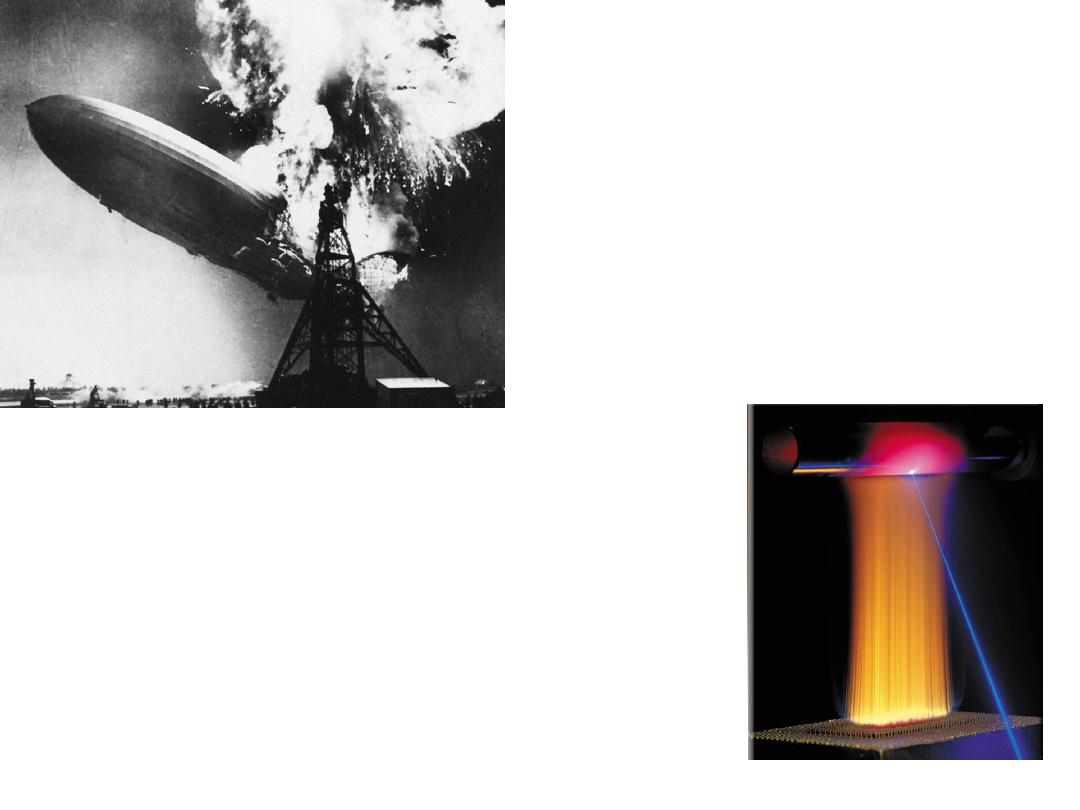
Thermochemistry
Chapter 6
Copyright © The McGraw-Hill Companies, Inc. Permission required for reproduction or display.

Energy is the capacity to do work
•
Radiant energy comes from the sun and is
earth’s primary energy source
•
Thermal energy is the energy associated with
the random motion of atoms and molecules
•
Chemical energy is the energy stored within the
bonds of chemical substances
•
Nuclear energy is the energy stored within the
collection of neutrons and protons in the atom
•
Potential energy is the energy available by virtue
of an object’s position
6.1
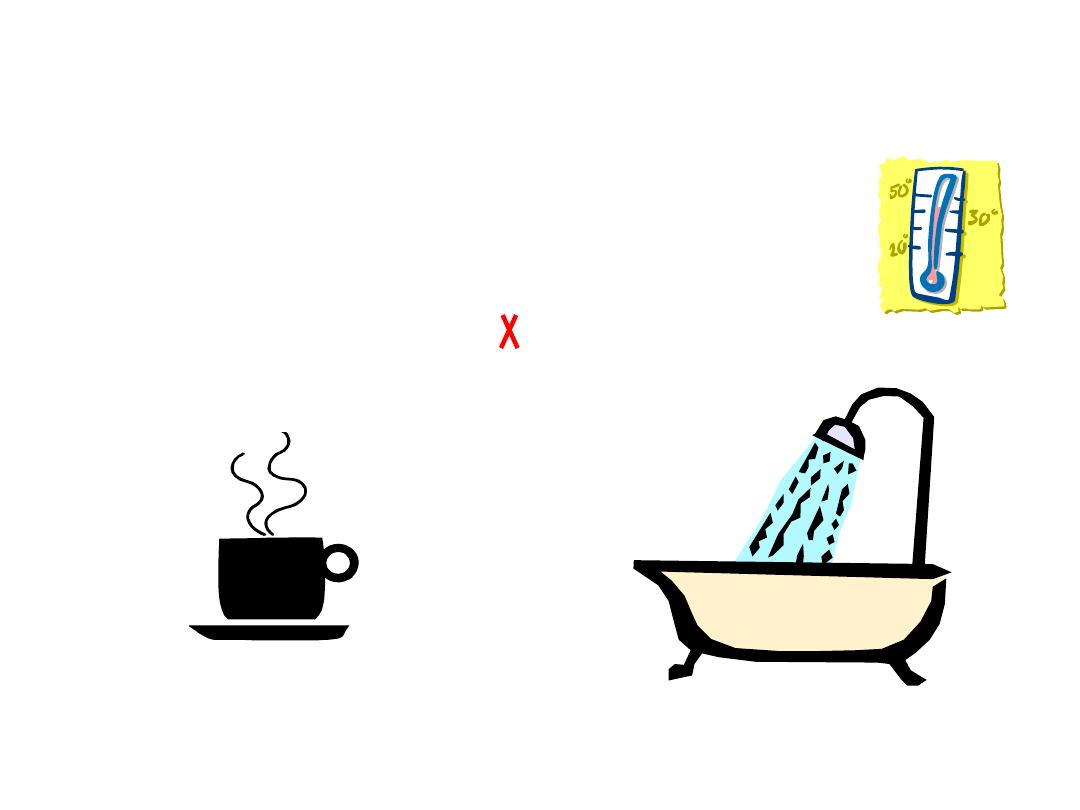
Heat is the transfer of thermal energy between two bodies that
are at different temperatures.
Energy Changes in Chemical Reactions
Temperature is a measure of the thermal energy.
90
0
C
40
0
C
greater thermal energy
6.2
Temperature = Thermal Energy
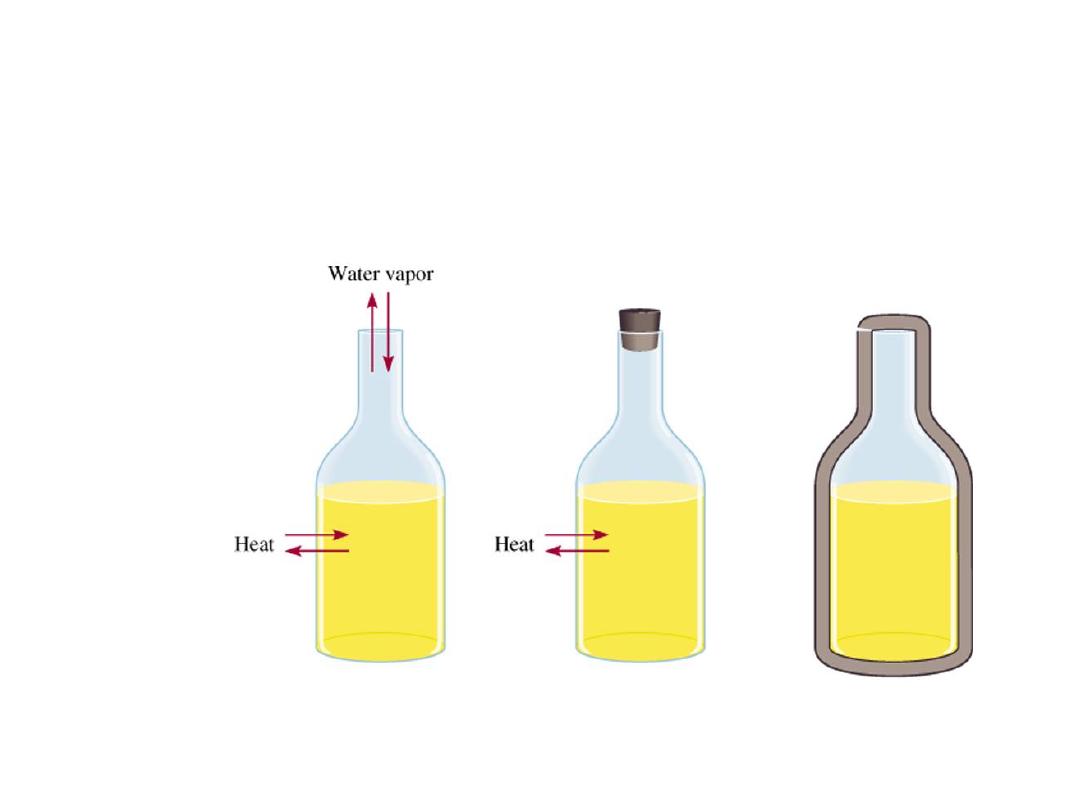
Thermochemistry is the study of heat change in chemical
reactions.
The system is the specific part of the universe that is of
interest in the study.
open
mass & energy
Exchange:
closed
energy
isolated
nothing
6.2
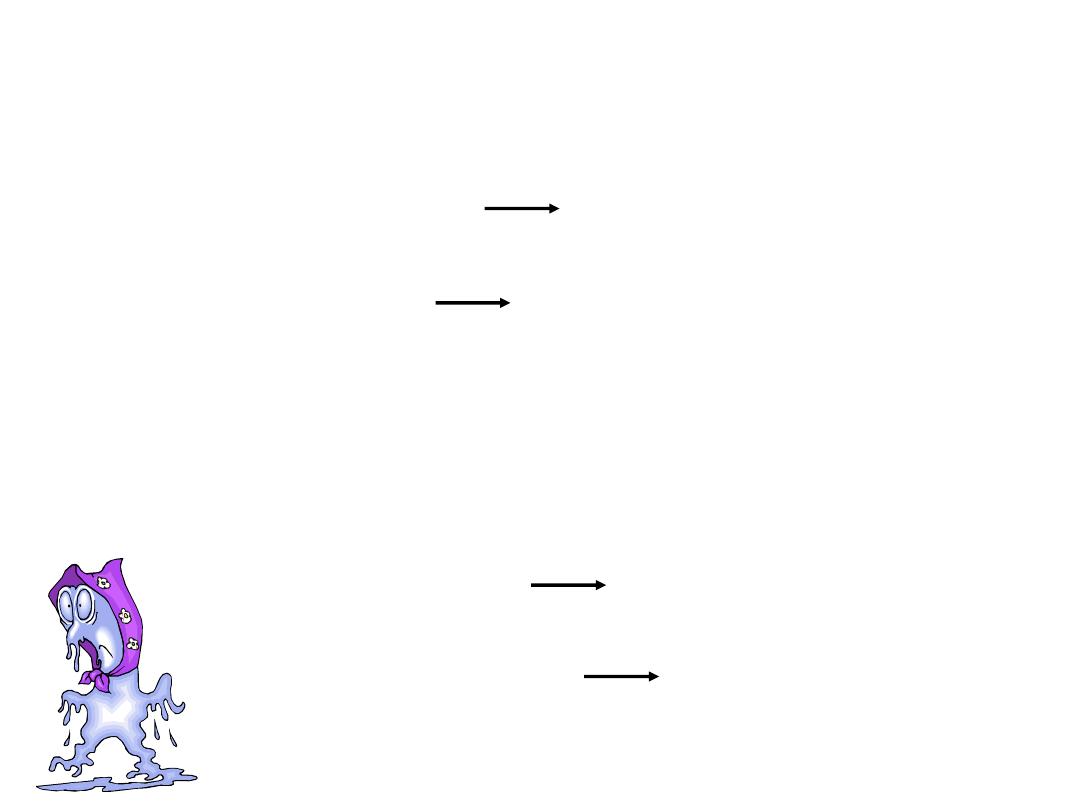
Exothermic process is any process that gives off heat
–
transfers thermal energy from the system to the surroundings.
Endothermic process is any process in which heat has to be
supplied to the system from the surroundings.
2H
2
(g)
+ O
2
(g)
2H
2
O
(l)
+ energy
H
2
O
(g)
H
2
O
(l)
+ energy
energy + 2HgO
(s)
2Hg
(l)
+ O
2
(g)
6.2
energy + H
2
O
(s)
H
2
O
(l)
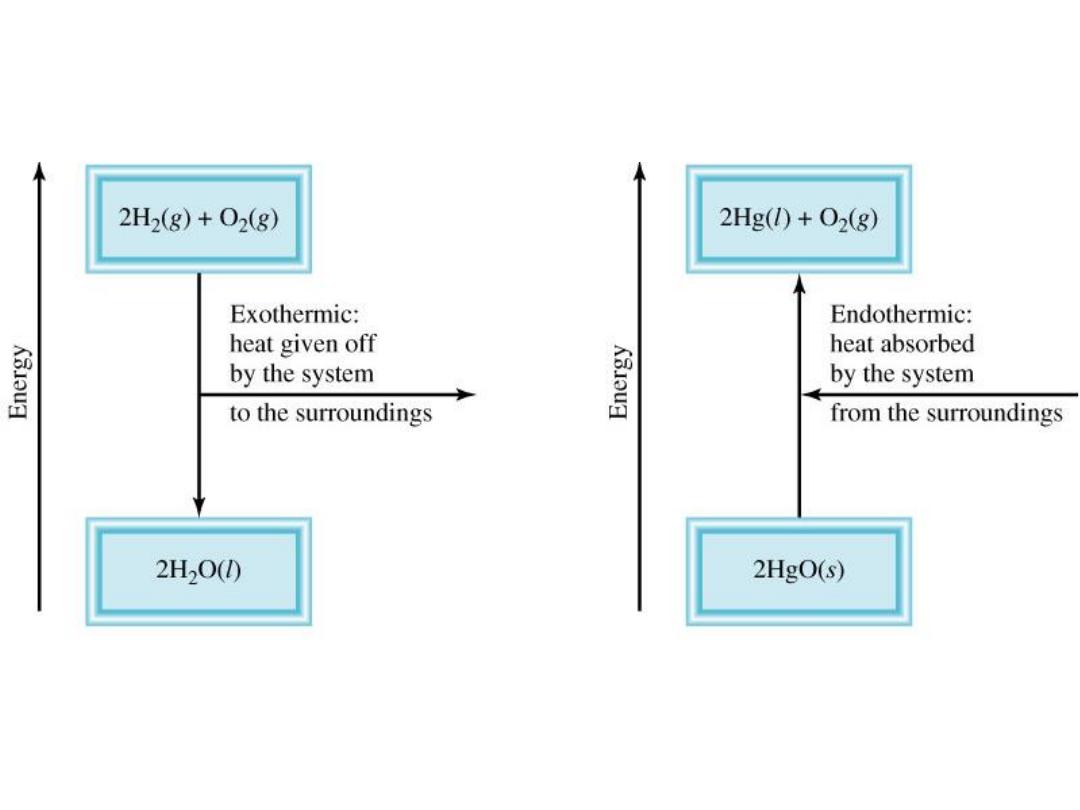
Exothermic
Endothermic
6.2

Thermodynamics is the scientific study of the
interconversion of heat and other kinds of energy.
State functions are properties that are determined by the state
of the system, regardless of how that condition was achieved.
Potential energy of
hiker 1
and
hiker 2
is the same even though they took
different paths.
energy, pressure, volume, temperature
6.3
D
E = E
final
- E
initial
D
P = P
final
- P
initial
D
V = V
final
- V
initial
D
T = T
final
- T
initial
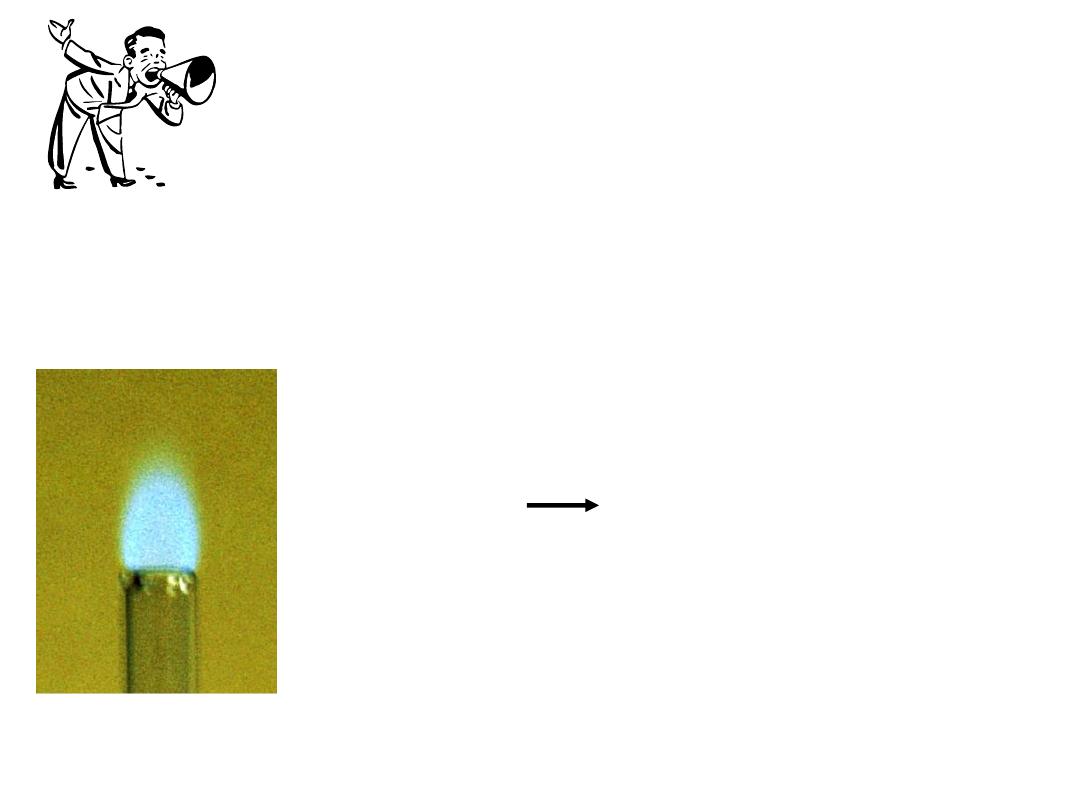
First law of thermodynamics
– energy
can be converted from one form to another,
but cannot be created or destroyed.
D
E
system
+
D
E
surroundings
= 0
or
D
E
system
= -
D
E
surroundings
C
3
H
8
+ 5O
2
3CO
2
+ 4H
2
O
Exothermic chemical reaction!
6.3
Chemical energy lost by combustion = Energy gained by the surroundings
system
surroundings
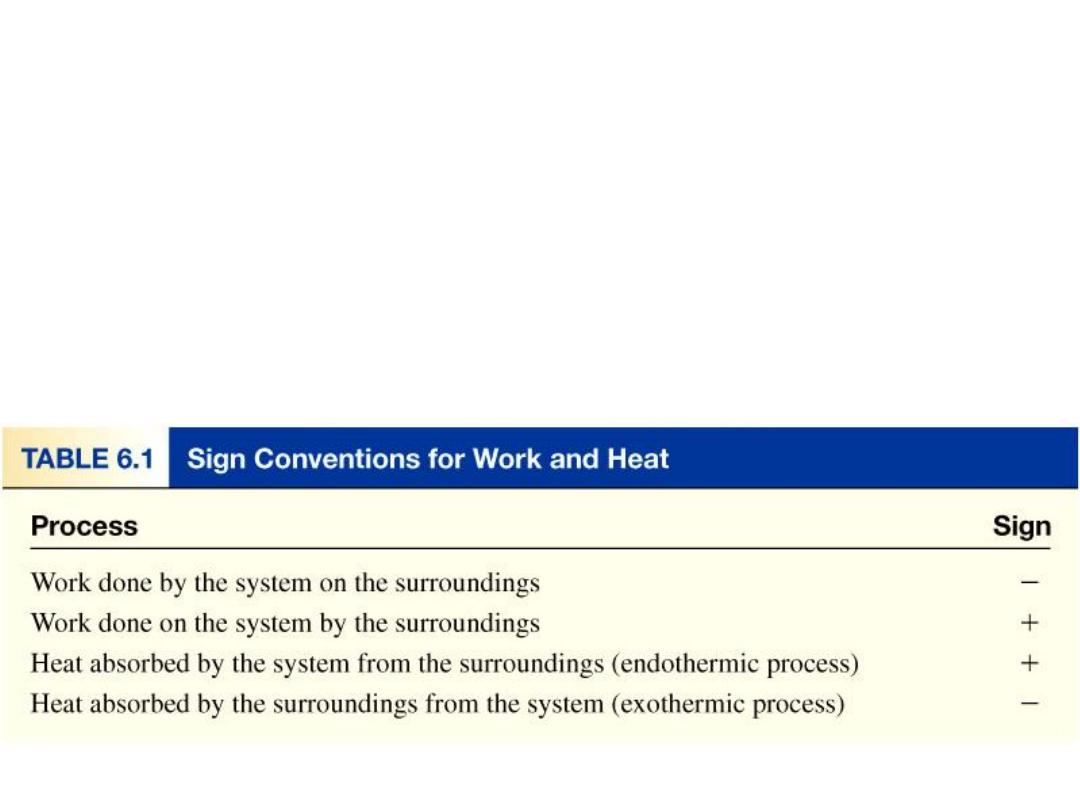
Another form of the first law for
DE
system
6.3
DE = q + w
DE is the change in internal energy of a system
q is the heat exchange between the system and the surroundings
w is the work done on (or by) the system
w = -P
D
V
when a gas expands against a constant external pressure
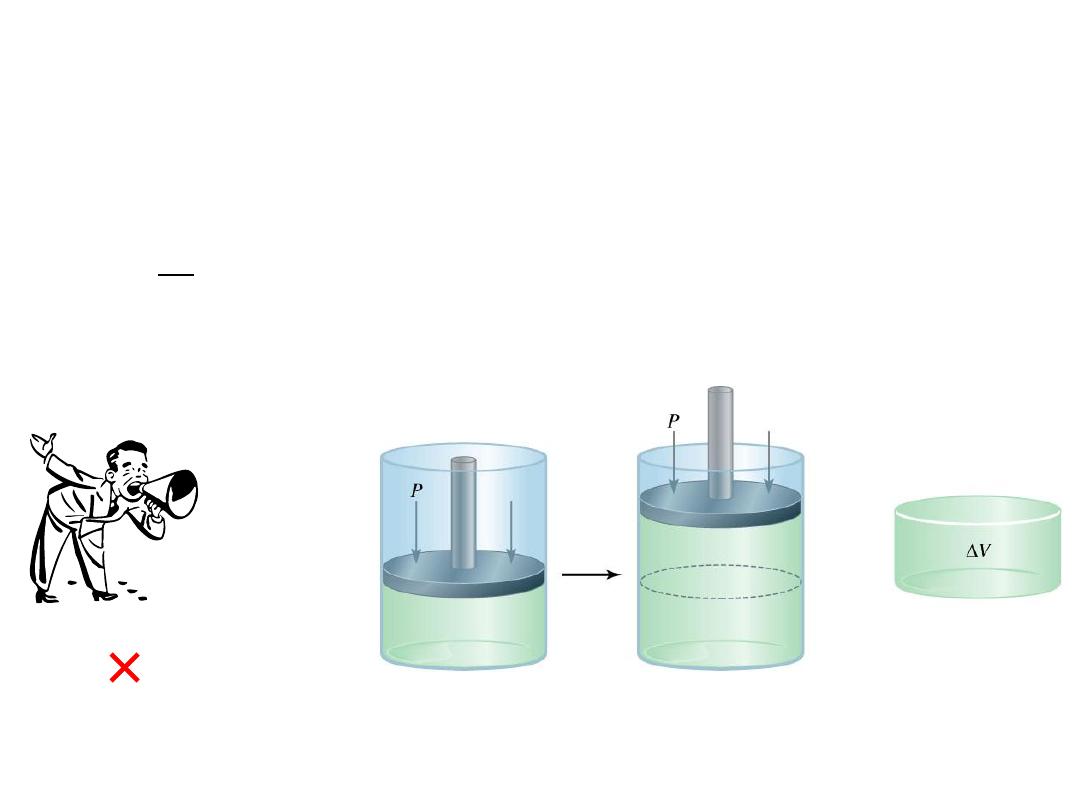
Work Done By the System
6.3
w = F x d
w = -P
D
V
P x V = x d
3
= F x d = w
F
d
2
DV > 0
-P
D
V < 0
w
sys
< 0
Work is
not a
state
function!
D
w = w
final
- w
initial
initial
final

A sample of nitrogen gas expands in volume from 1.6 L to
5.4 L at constant temperature. What is the work done in
joules if the gas expands (a) against a vacuum and (b)
against a constant pressure of 3.7 atm?
w = -P
D
V
(a)
D
V = 5.4 L
– 1.6 L = 3.8 L
P = 0 atm
W = -0 atm x 3.8 L = 0 L
•atm = 0 joules
(b)
D
V = 5.4 L
– 1.6 L = 3.8 L
P = 3.7 atm
w = -3.7 atm x 3.8 L = -14.1 L
•atm
w = -14.1 L
•atm x 101.3 J
1L
•atm
= -1430 J
6.3
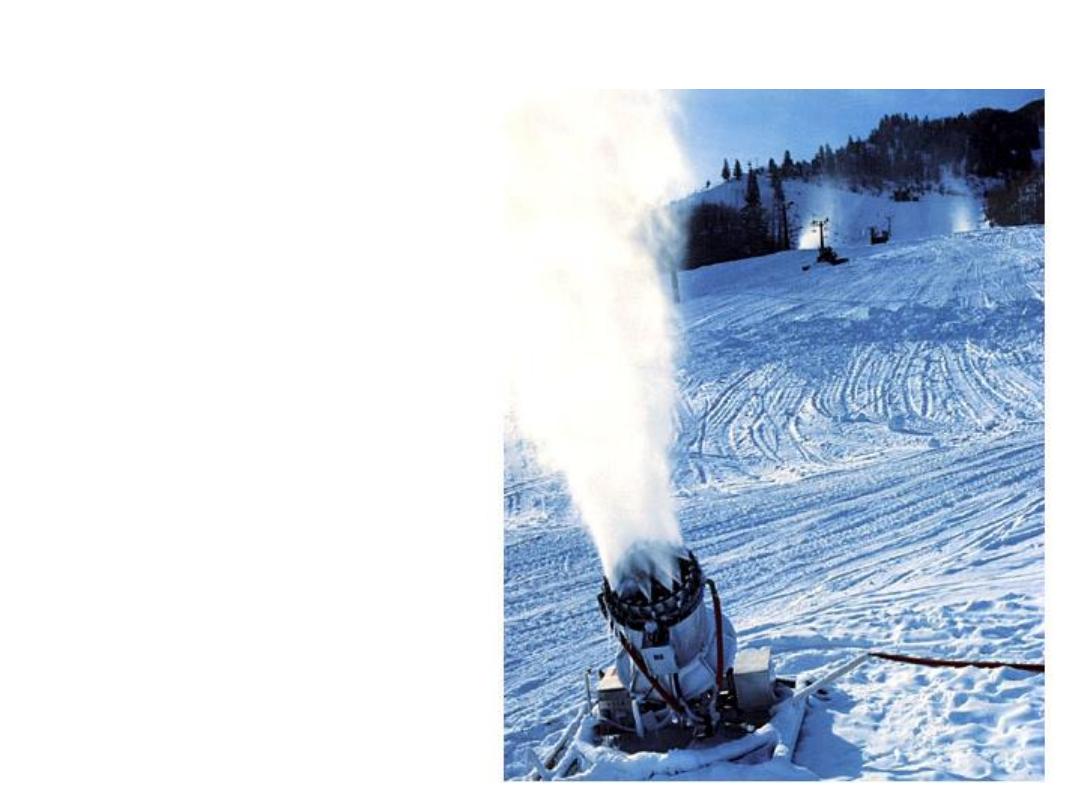
Chemistry in Action: Making Snow
D
E = q + w
q = 0
w < 0,
DE < 0
D
E = C
D
T
DT < 0, SNOW!

Enthalpy and the First Law of Thermodynamics
6.4
DE = q + w
DE = DH - PDV
DH = DE + PDV
q =
DH and w = -PDV
At constant pressure:
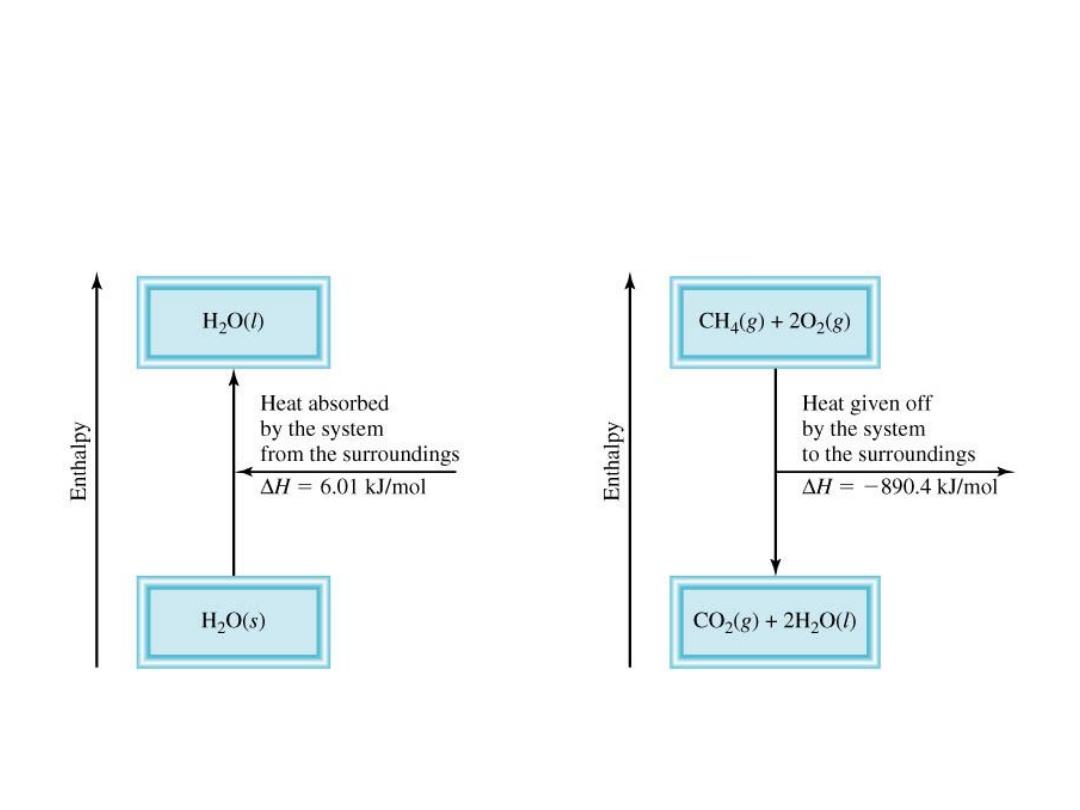
Enthalpy (H) is used to quantify the heat flow into or out of a
system in a process that occurs at constant pressure.
DH = H (products) – H (reactants)
DH =
heat given off or absorbed during a reaction at constant pressure
H
products
> H
reactants
DH > 0
H
products
< H
reactants
DH < 0
6.4
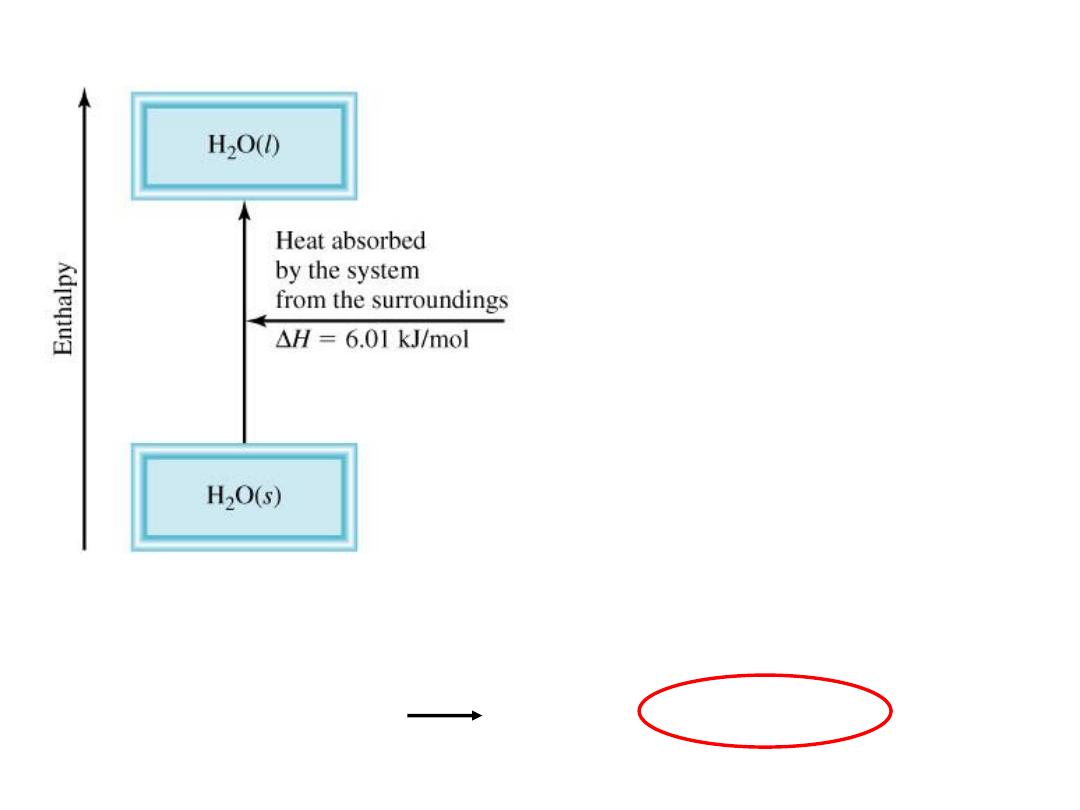
Thermochemical Equations
H
2
O
(s)
H
2
O
(l)
DH = 6.01 kJ
Is
DH negative or positive?
System absorbs heat
Endothermic
DH > 0
6.01 kJ are absorbed for every 1 mole of ice that
melts at 0
0
C and 1 atm.
6.4
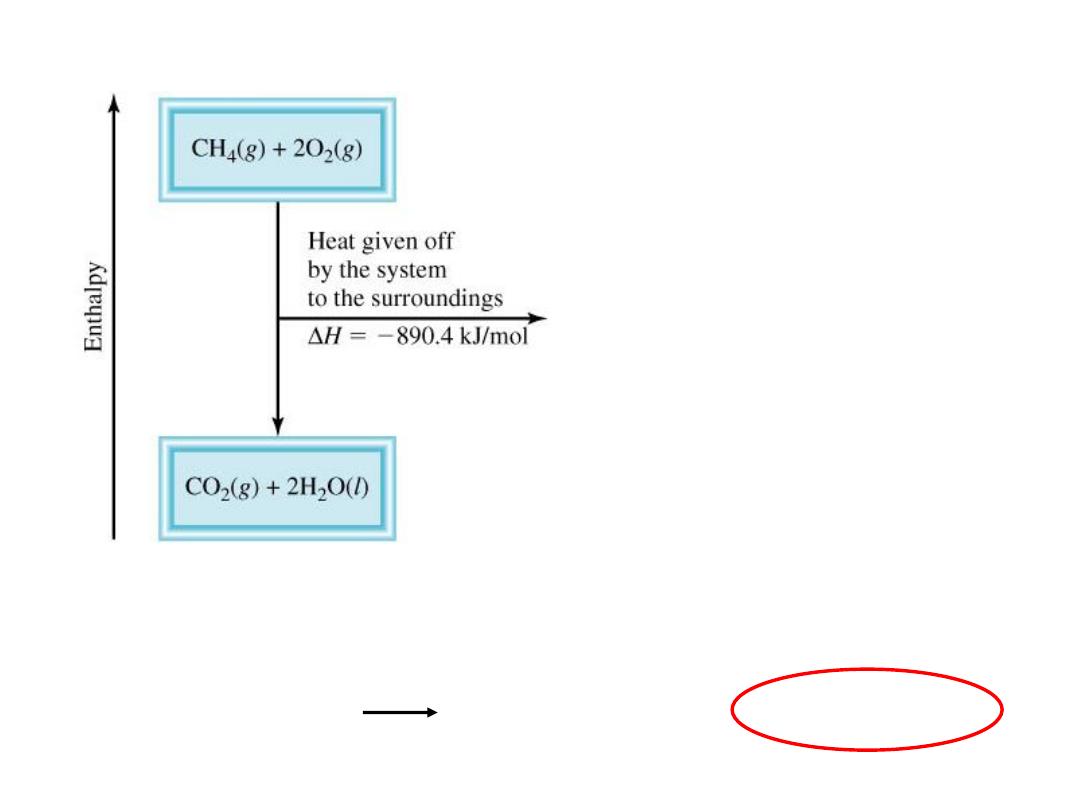
Thermochemical Equations
CH
4
(g)
+ 2O
2
(g)
CO
2
(g)
+ 2H
2
O
(l)
DH = -890.4 kJ
Is
DH negative or positive?
System gives off heat
Exothermic
DH < 0
890.4 kJ are released for every 1 mole of methane
that is combusted at 25
0
C and 1 atm.
6.4
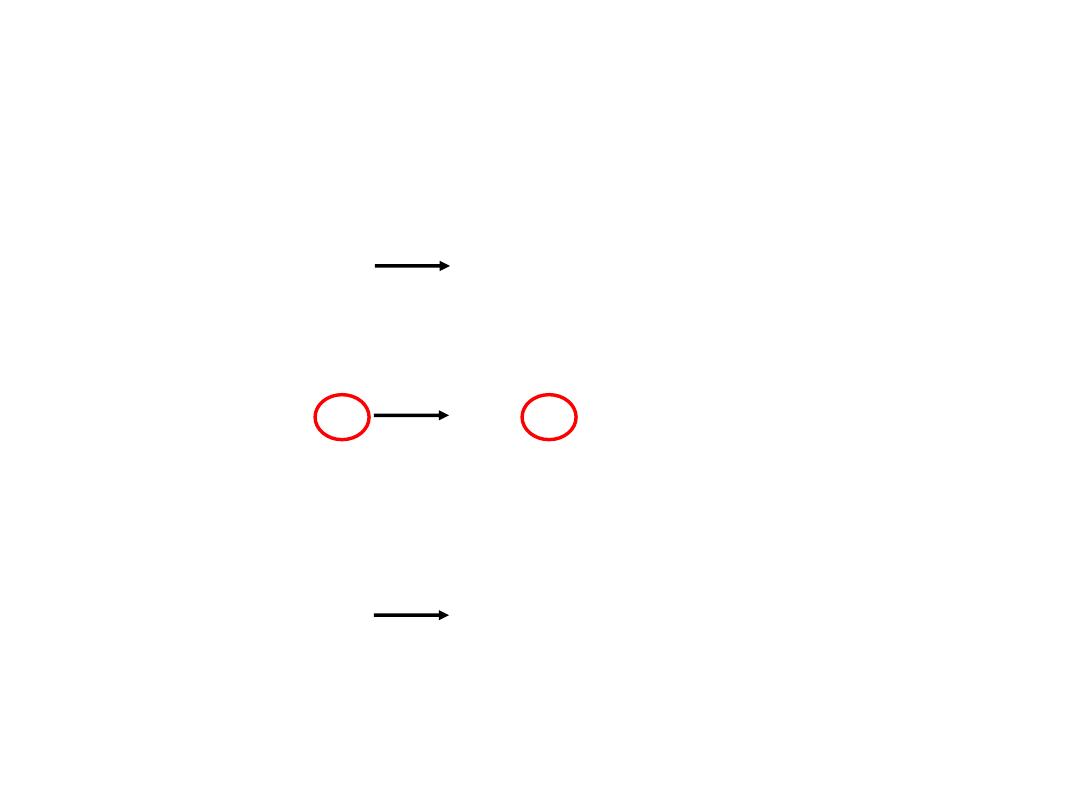
H
2
O
(s)
H
2
O
(l)
DH = 6.01 kJ
•
The stoichiometric coefficients always refer to the number
of moles of a substance
Thermochemical Equations
•
If you reverse a reaction, the sign of
DH changes
H
2
O
(l)
H
2
O
(s)
DH =
-
6.01
kJ
•
If you multiply both sides of the equation by a factor n,
then
DH must change by the same factor n.
2H
2
O
(s)
2H
2
O
(l)
DH =
2 x
6.01 = 12.0 kJ
6.4
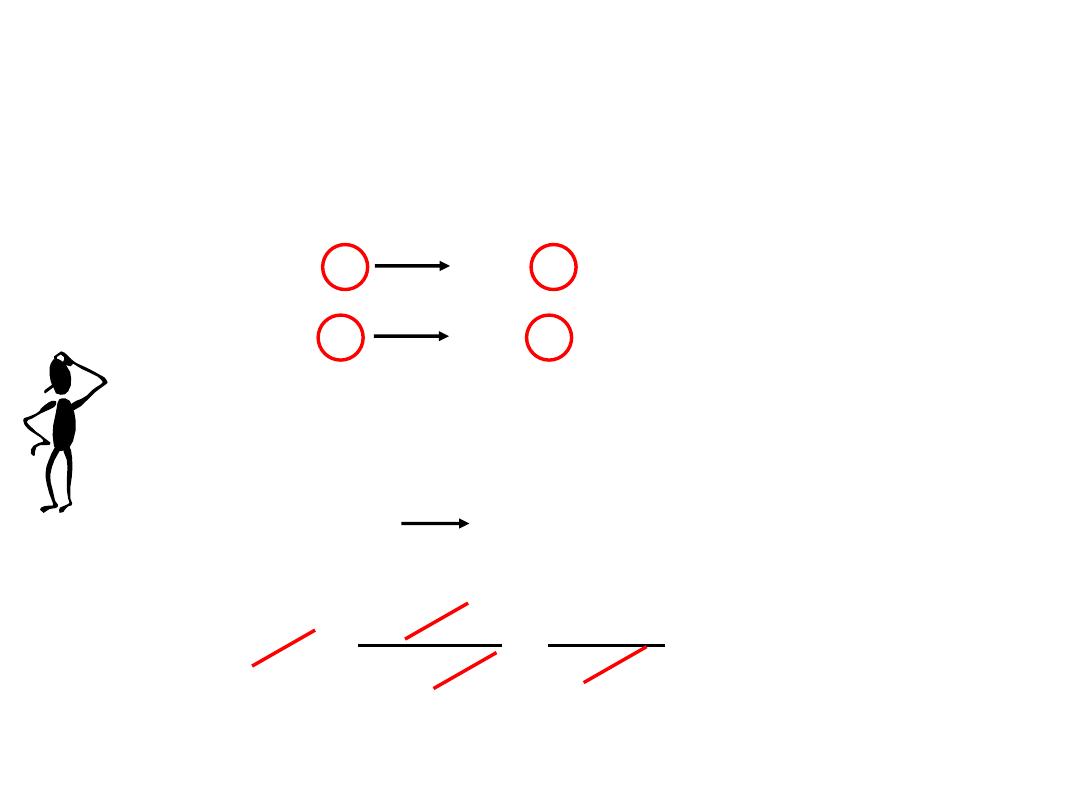
H
2
O
(s)
H
2
O
(l)
DH = 6.01 kJ
•
The physical states of all reactants and products must be
specified in thermochemical equations.
Thermochemical Equations
6.4
H
2
O
(l)
H
2
O
(g)
DH = 44.0 kJ
How much heat is evolved when 266 g of white
phosphorus (P
4
) burn in air?
P
4
(s)
+ 5O
2
(g)
P
4
O
10
(s)
DH = -3013 kJ/mol P
4
266 g P
4
1 mol P
4
123.9 g P
4
x
3013 kJ
1 mol P
4
x
= 6470 kJ
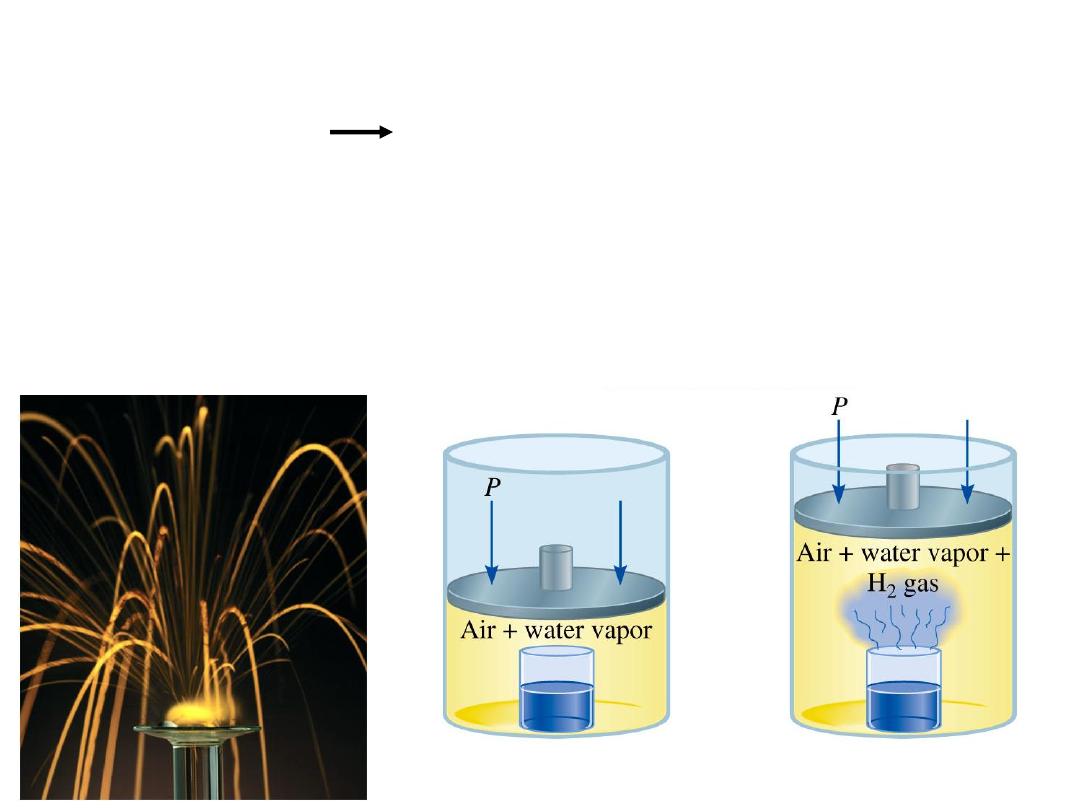
A Comparison of
D
H and
D
E
2Na (s) + 2H
2
O (l) 2NaOH (aq) + H
2
(g)
DH = -367.5 kJ/mol
DE = DH - PDV
At 25
0
C, 1 mole H
2
= 24.5 L at 1 atm
P
D
V = 1 atm x 24.5 L = 2.5 kJ
D
E = -367.5 kJ/mol
– 2.5 kJ/mol = -370.0 kJ/mol
6.4
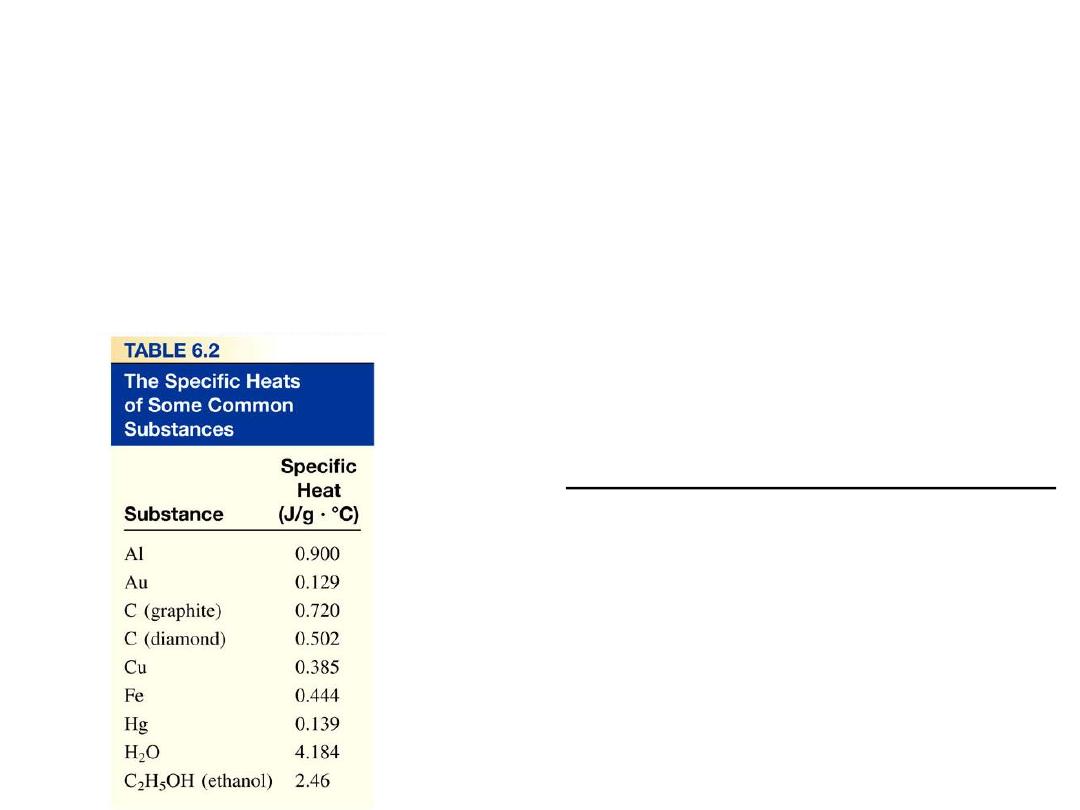
The specific heat (s) of a substance is the amount of heat (q)
required to raise the temperature of one gram of the
substance by one degree Celsius.
The heat capacity (C) of a substance is the amount of heat
(q) required to raise the temperature of a given quantity (m)
of the substance by one degree Celsius.
C = m x s
Heat (q) absorbed or released:
q = m x s x
Dt
q = C x
Dt
Dt = t
final
- t
initial
6.5
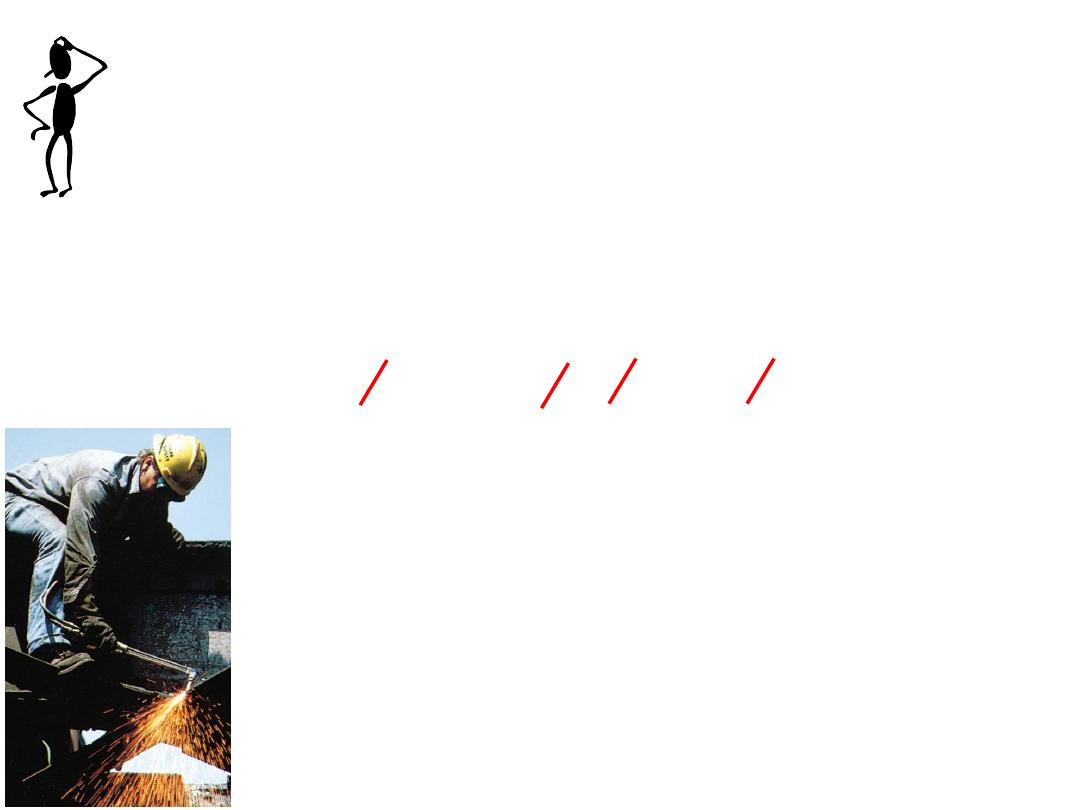
How much heat is given off when an 869 g iron bar cools
from 94
0
C to 5
0
C?
s of Fe = 0.444 J/g
•
0
C
Dt = t
final
– t
initial
= 5
0
C
– 94
0
C = -89
0
C
q = ms
Dt = 869 g x 0.444 J/g
•
0
C x
–89
0
C = -34,000 J
6.5
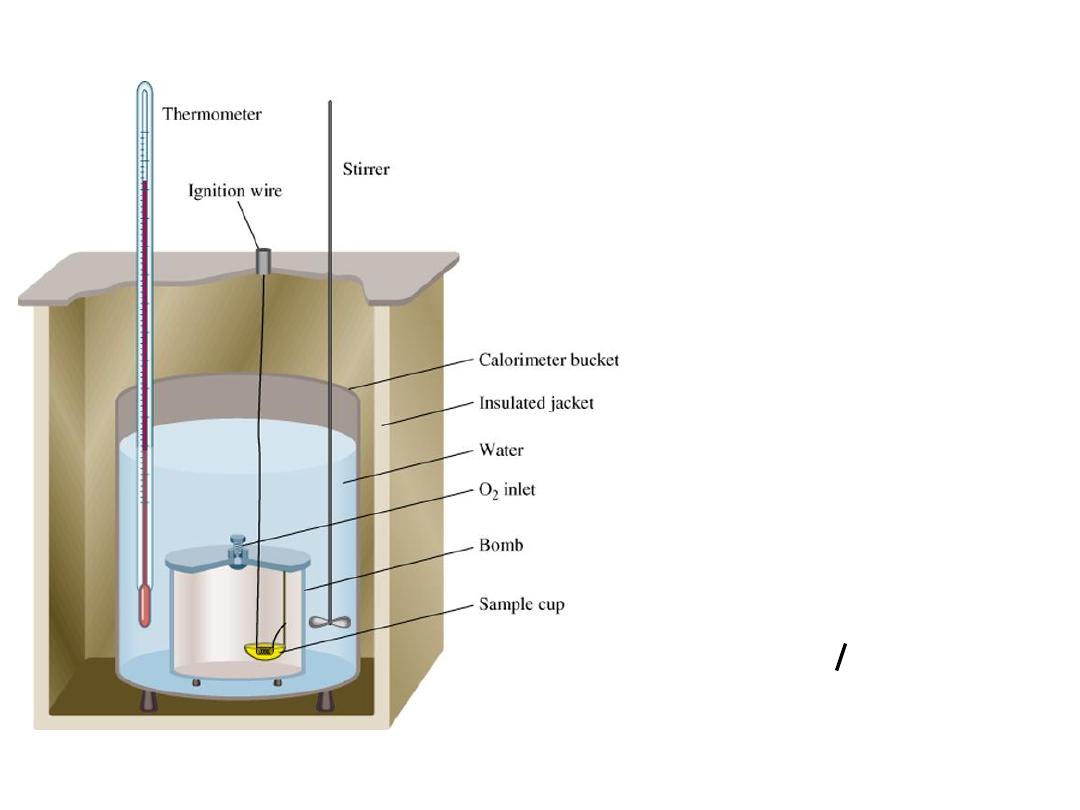
Constant-Volume Calorimetry
No heat enters or leaves!
q
sys
= q
water
+ q
bomb
+ q
rxn
q
sys
= 0
q
rxn
= - (q
water
+ q
bomb
)
q
water
= m x s x
Dt
q
bomb
= C
bomb
x
Dt
6.5
Reaction at Constant V
DH ~ q
rxn
DH = q
rxn
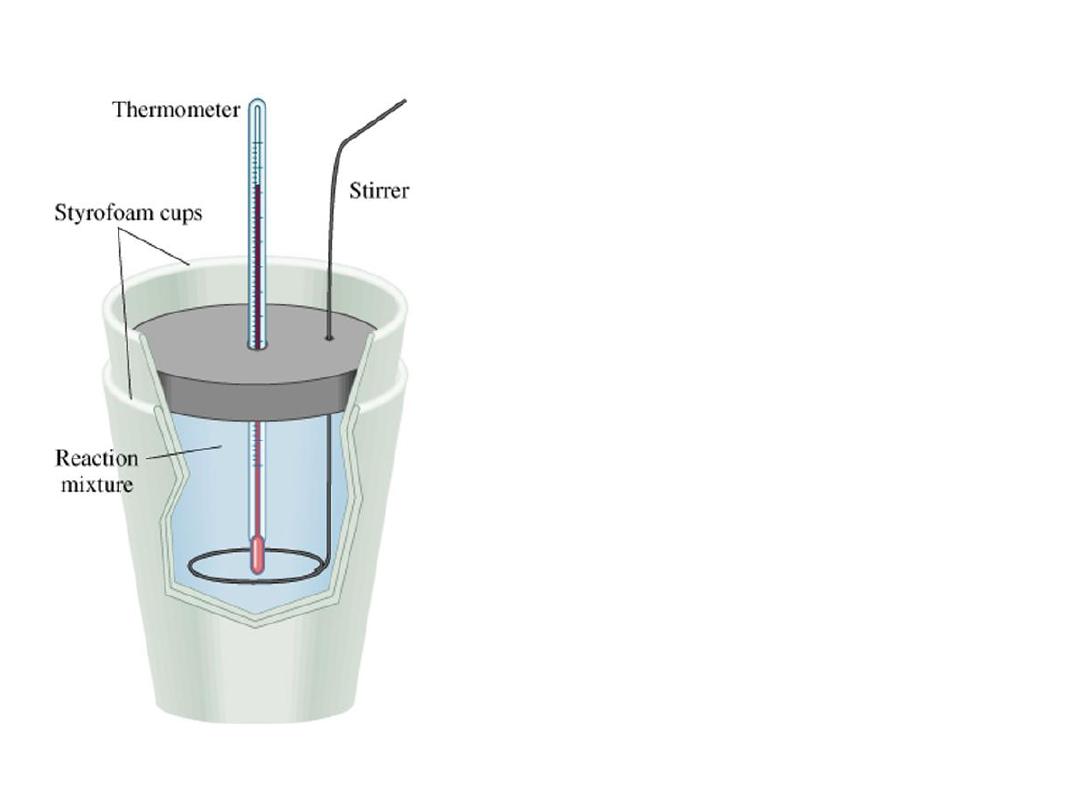
Constant-Pressure Calorimetry
No heat enters or leaves!
q
sys
= q
water
+ q
cal
+ q
rxn
q
sys
= 0
q
rxn
= - (q
water
+ q
cal
)
q
water
= m x s x
Dt
q
cal
= C
cal
x
Dt
6.5
Reaction at Constant P
DH = q
rxn
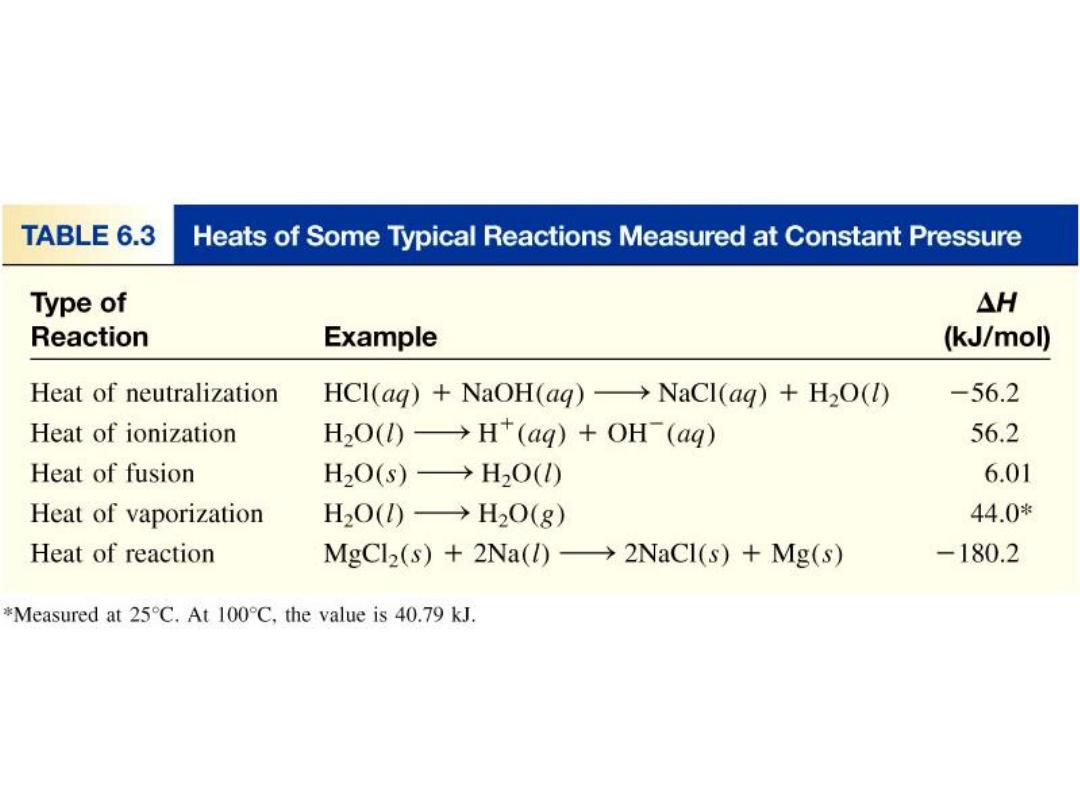
6.5
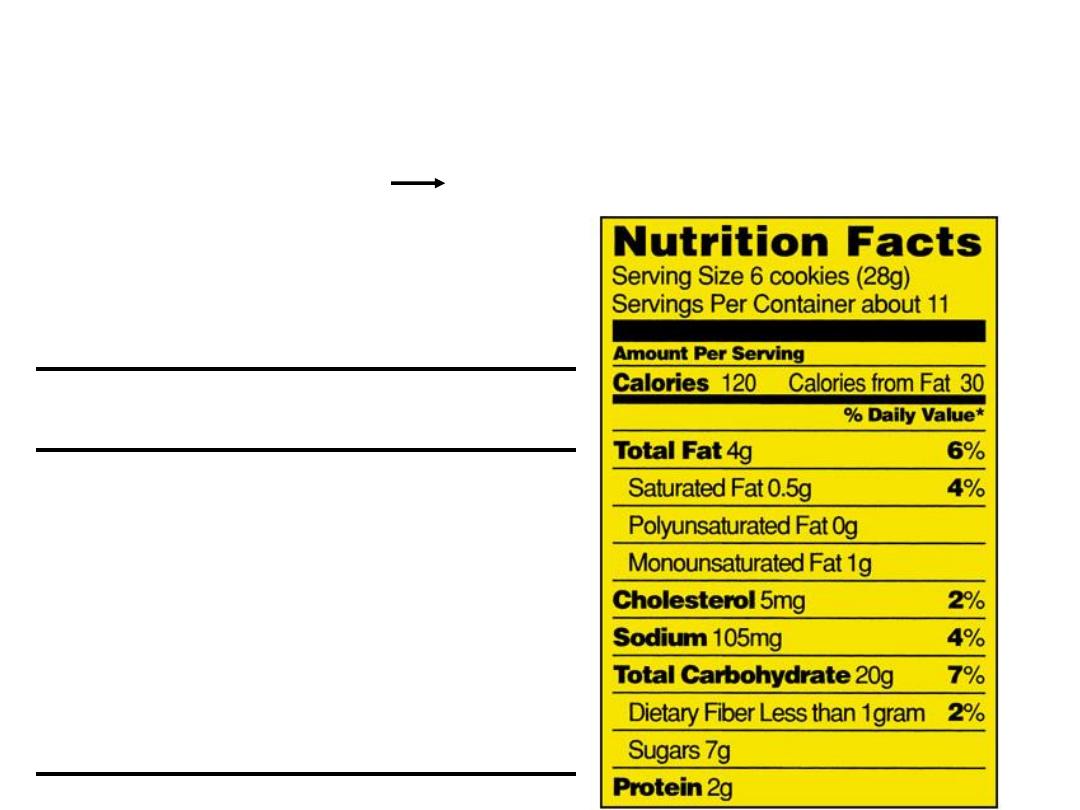
Chemistry in Action:
Fuel Values of Foods and Other Substances
C
6
H
12
O
6
(s) + 6O
2
(g) 6CO
2
(g) + 6H
2
O (l)
DH = -2801 kJ/mol
1 cal = 4.184 J
1 Cal = 1000 cal = 4184 J
Substance
D
H
combustion
(kJ/g)
Apple
-2
Beef
-8
Beer
-1.5
Gasoline
-34

Because there is no way to measure the absolute value of
the enthalpy of a substance, must I measure the enthalpy
change for every reaction of interest?
Establish an arbitrary scale with the standard enthalpy of
formation (
DH
0
) as a reference point for all enthalpy
expressions.
f
Standard enthalpy of formation (
DH
0
) is the heat change
that results when one mole of a compound is formed from
its elements at a pressure of 1 atm.
f
The standard enthalpy of formation of any element in its
most stable form is zero.
DH
0
(O
2
) = 0
f
DH
0
(O
3
) = 142 kJ/mol
f
DH
0
(C, graphite) = 0
f
DH
0
(C, diamond) = 1.90 kJ/mol
f
6.6
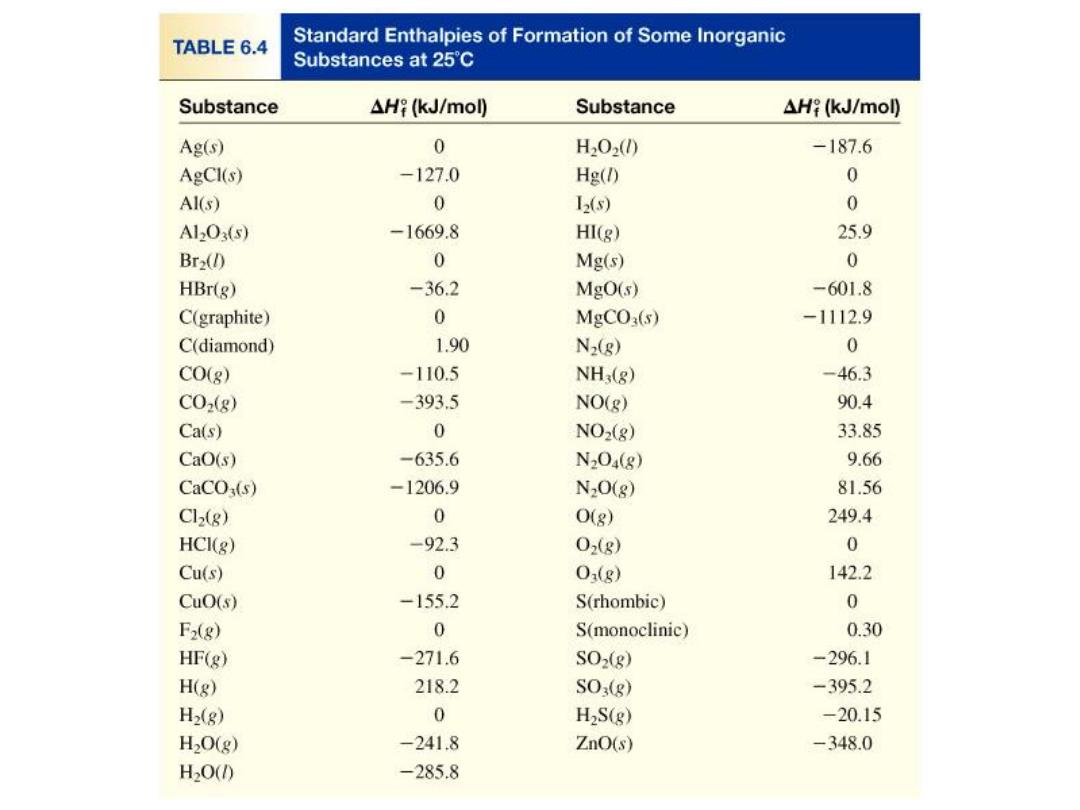
6.6
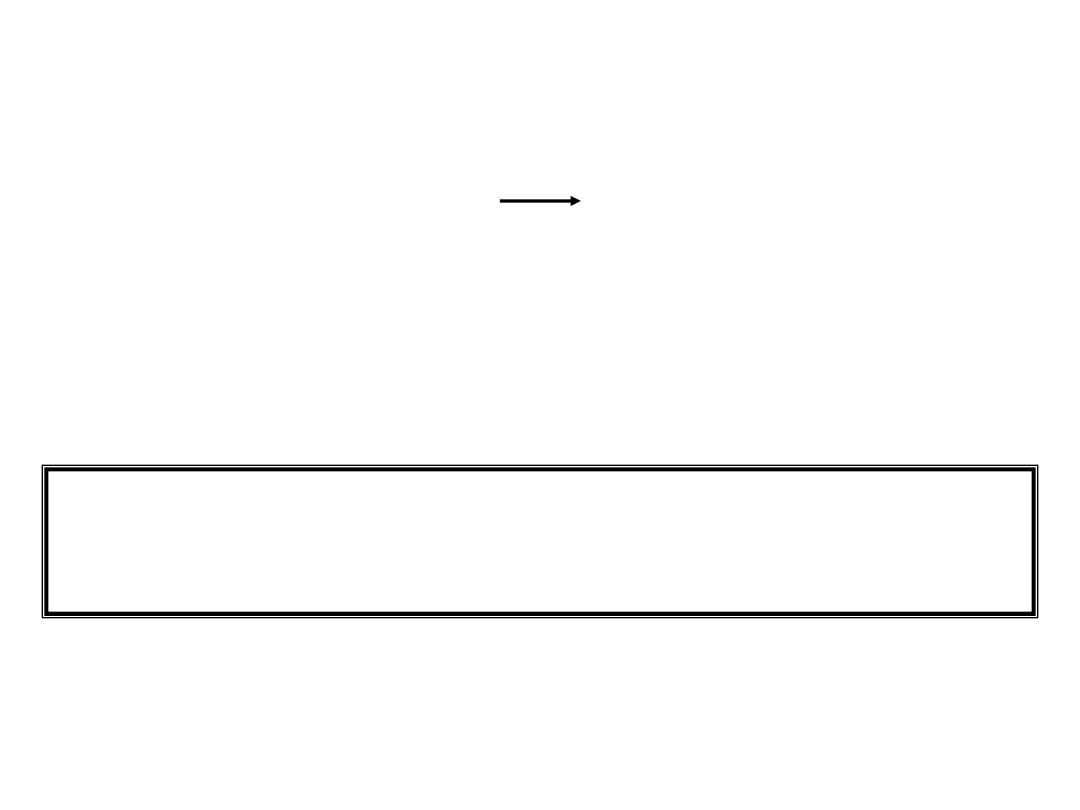
The standard enthalpy of reaction (
DH
0
) is the enthalpy of
a reaction carried out at 1 atm.
rxn
aA + bB cC + dD
DH
0
rxn
d
DH
0
(D)
f
c
DH
0
(C)
f
= [
+
] -
b
DH
0
(B)
f
a
DH
0
(A)
f
[
+
]
DH
0
rxn
n
DH
0
(products)
f
= S
m
DH
0
(reactants)
f
S
-
6.6
Hess’s Law: When reactants are converted to products, the
change in enthalpy is the same whether the reaction takes
place in one step or in a series of steps.
(Enthalpy is a state function. It doesn’t matter how you get
there, only where you start and end.)
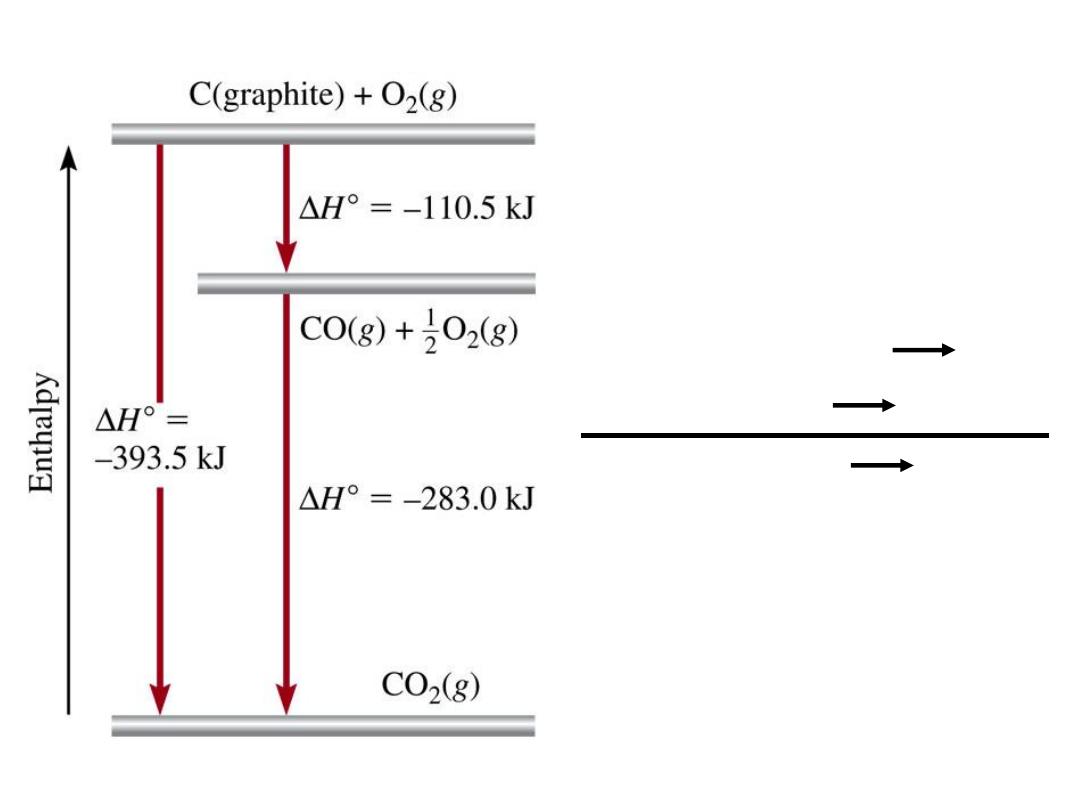
C
(graphite)
+ 1/2O
2
(g)
CO
(g)
CO
(g)
+ 1/2O
2
(g)
CO
2
(g)
C
(graphite)
+ O
2
(g)
CO
2
(g)
6.6
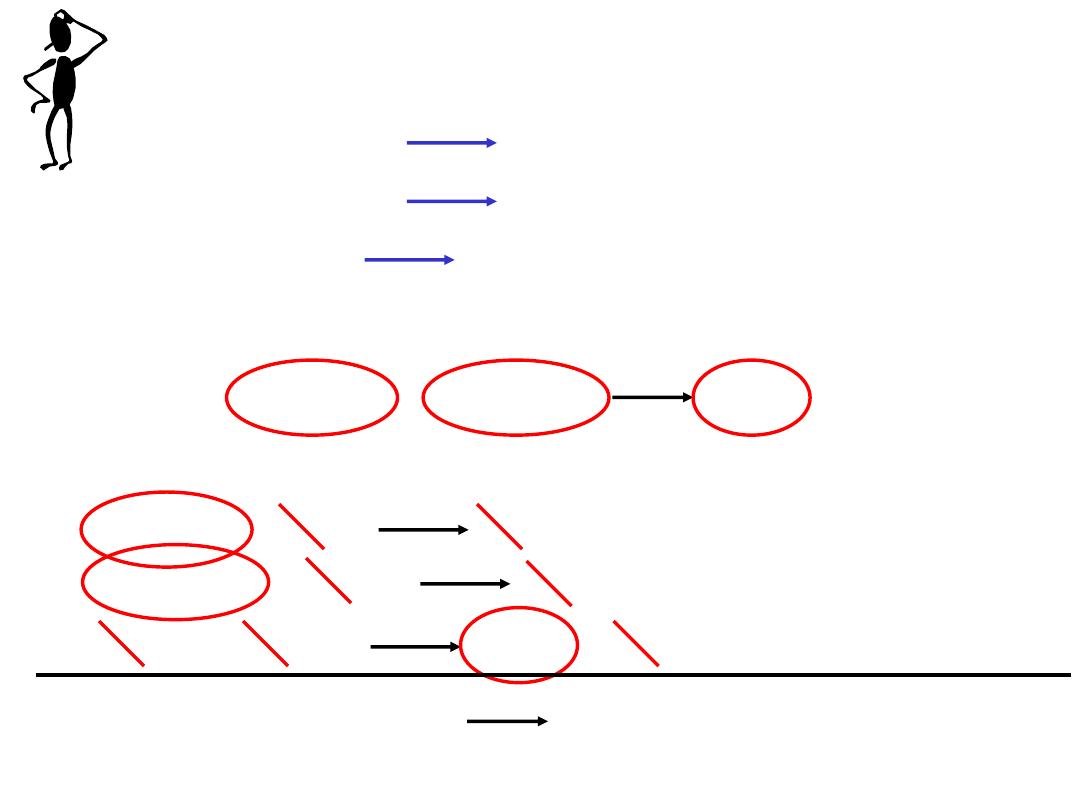
Calculate the standard enthalpy of formation of CS
2
(l)
given that:
C
(graphite)
+ O
2
(g)
CO
2
(g)
DH
0
= -393.5 kJ
rxn
S
(rhombic)
+ O
2
(g)
SO
2
(g)
DH
0
= -296.1 kJ
rxn
CS
2
(l)
+ 3O
2
(g)
CO
2
(g)
+ 2SO
2
(g)
DH
0
= -1072 kJ
rxn
1. Write the enthalpy of formation reaction for CS
2
C
(graphite)
+ 2S
(rhombic)
CS
2
(l)
2. Add the given rxns so that the result is the desired rxn.
rxn
C
(graphite)
+ O
2
(g)
CO
2
(g)
DH
0
= -393.5 kJ
2S
(rhombic)
+ 2O
2
(g)
2SO
2
(g)
DH
0
= -296.1
x2
kJ
rxn
CO
2
(g)
+ 2SO
2
(g)
CS
2
(l)
+ 3O
2
(g)
DH
0
=
+1072
kJ
rxn
+
C
(graphite)
+ 2S
(rhombic)
CS
2
(l)
DH
0
= -393.5 + (2x-296.1) + 1072 = 86.3 kJ
rxn
6.6
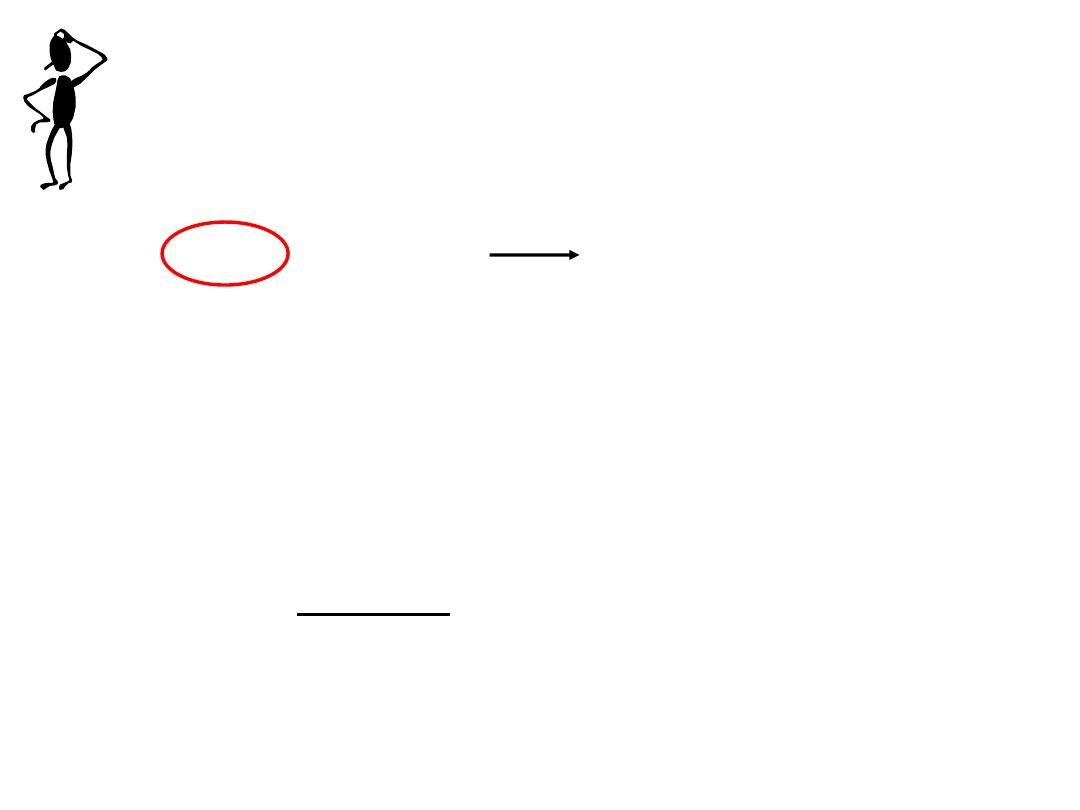
Benzene (C
6
H
6
) burns in air to produce carbon dioxide and
liquid water. How much heat is released per mole of
benzene combusted? The standard enthalpy of formation
of benzene is 49.04 kJ/mol.
2C
6
H
6
(l)
+ 15O
2
(g)
12CO
2
(g)
+ 6H
2
O
(l)
DH
0
rxn
n
DH
0
(products)
f
= S
m
DH
0
(reactants)
f
S
-
DH
0
rxn
6
DH
0
(H
2
O)
f
12
DH
0
(CO
2
)
f
= [
+
] -
2
DH
0
(C
6
H
6
)
f
[
]
DH
0
rxn
= [ 12x–393.5 + 6x–285.83] – [ 2x49.04 ] = -6534 kJ
-6534 kJ
2 mol
= - 3267 kJ/mol C
6
H
6
6.6
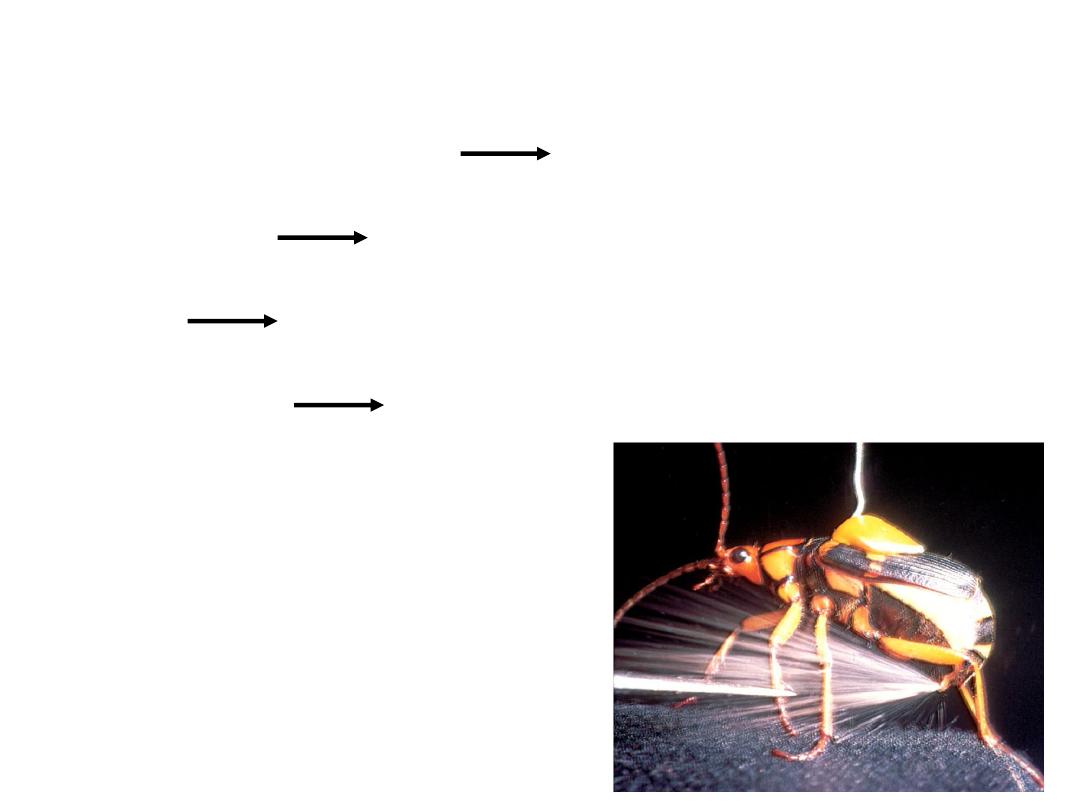
Chemistry in Action: Bombardier Beetle Defense
C
6
H
4
(OH)
2
(aq)
+ H
2
O
2
(aq)
C
6
H
4
O
2
(aq)
+ 2H
2
O
(l)
D
H
0
= ?
C
6
H
4
(OH)
2
(aq)
C
6
H
4
O
2
(aq)
+ H
2
(g)
D
H
0
= 177 kJ/mol
H
2
O
2
(aq)
H
2
O
(l)
+ ½O
2
(g)
D
H
0
= -94.6 kJ/mol
H
2
(g)
+ ½ O
2
(g)
H
2
O
(l)
D
H
0
= -286 kJ/mol
D
H
0
= 177 - 94.6
– 286 = -204 kJ/mol
Exothermic!
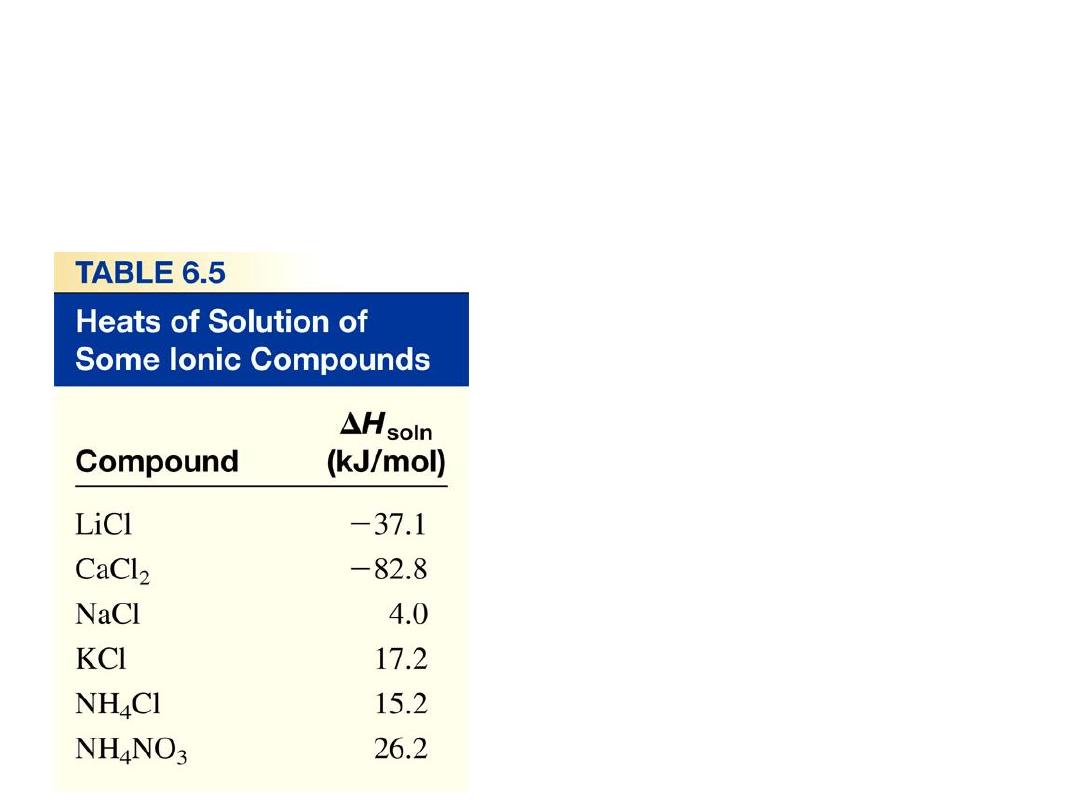
The enthalpy of solution (
D
H
soln
) is the heat generated or
absorbed when a certain amount of solute dissolves in a
certain amount of solvent.
DH
soln
= H
soln
- H
components
6.7
Which substance(s) could be
used for melting ice?
Which substance(s) could be
used for a cold pack?
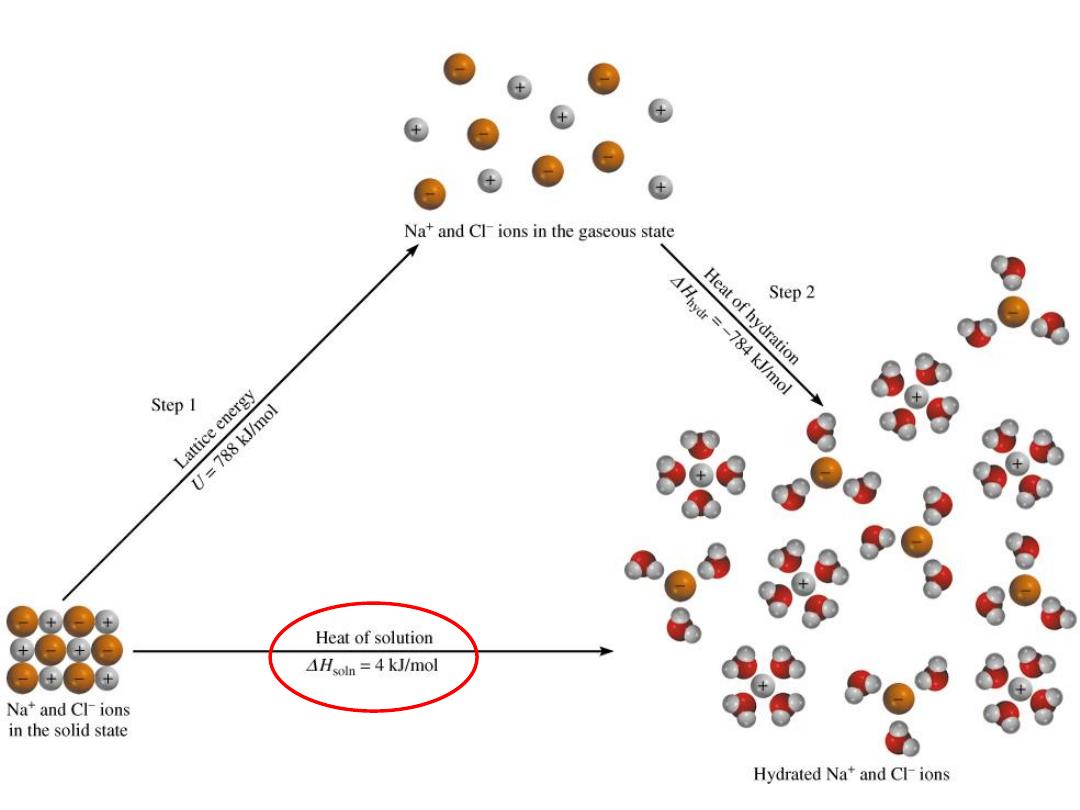
The Solution Process for NaCl
D
H
soln
=
Step 1 + Step 2 = 788
– 784 = 4 kJ/mol
6.7
